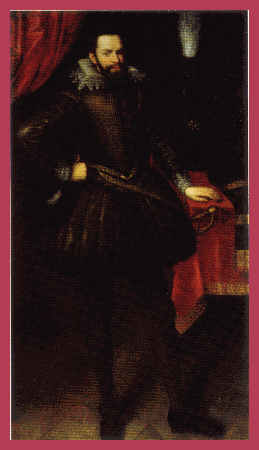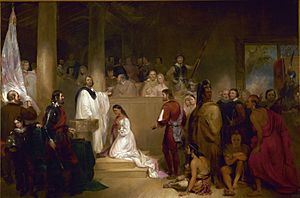Thomas Dale facts for kids
Quick facts for kids
Thomas Dale
|
|
|---|---|
 |
|
| Born | c. 1570 |
| Died | 19 August 1619 |
| Nationality | English |
| Occupation | Naval commander, deputy-governor of the Virginia Colony |
Sir Thomas Dale (born around 1570 – died August 19, 1619) was an English naval officer. He served as a leader in the Virginia Colony. He was the deputy-governor in 1611 and again from 1614 to 1616. People remember Governor Dale for his strong leadership. He brought order to the colony. He also helped it grow in many ways. Some people thought he was too strict. He is also known for starting new settlements. These include Bermuda Hundred, Bermuda Cittie, and Henricus.
Contents
Sir Thomas Dale's Story
Early Life and Military Service
From about 1588 to 1609, Thomas Dale worked for the English army. He served in the Low Countries (which are now the Netherlands and parts of Belgium). He became friends with important people. This was because he was skilled and ambitious. In 1599, the Earl of Essex asked him to join England's army. King James made him a knight on June 16, 1606. He became "Sir Thomas Dale of Surry."
While Dale was still in the Low Countries, King James's oldest son, Henry Frederick, Prince of Wales, recommended him. The Dutch government agreed that Captain Thomas Dale could leave his army company for three years. This was so he could work for the King in Virginia. His company would wait for him to return if he wanted.
Leading the Virginia Colony
Five years later, the Virginia Company of London sent Sir Thomas Dale to Virginia. He was to be the deputy-governor or "Marshall of Virginia." This was a new and important job. He worked under Thomas West, 3rd Baron De La Warr (Lord Delaware). Dale arrived at Jamestown on May 19, 1611. He came with three ships, men, cattle, and supplies.
He found Jamestown to be unhealthy and needing much improvement. Dale quickly called a meeting of the Jamestown Council. He started teams to rebuild the settlement. He was acting Governor for about three and a half months in 1611. He then served for two years between 1614 and 1616. In between these times, he was the Marshall of the colony. He worked directly under Deputy Governor Sir Thomas Gates. For five years, he was the top law enforcement officer in Virginia.
He was very strict but also very effective. This strictness helped the colony greatly. During his time, Virginia's first set of laws was used. These laws were called "Articles, Lawes, and Orders Divine, Politique, and Martiall." People often called them Dale's Code. These laws were known for being very harsh. Dale himself helped write much of this code.
Economic Changes and New Settlements
Perhaps Dale's most lasting change was in the economy. In 1613, he changed how farming was done. Before, everyone worked together on communal farms. This was not working well. Dale gave 3-acre plots of land to the "ancient planters." These were the first settlers. Newer settlers received smaller plots. This helped the colony's economy improve a lot. Settlers began to farm more land. They even expanded onto land belonging to local native tribes.
Food production increased significantly. The next year, John Rolfe successfully grew the first hybrid tobacco on his plot. This tobacco became very important for the colony's future.
Dale wanted a better place than Jamestown for a main settlement. He sailed up the James River to what is now Chesterfield County, Virginia. He was impressed by the area where the Appomattox River joins the James River. There were talks of calling it "New Bermuda." (The island of Bermuda had become part of the Virginia Colony in 1612. This happened after the ship Sea Venture crashed there in 1609).
A bit further up the James River, in 1611, he started building Henricus. This new settlement was on and around what is now Farrar's Island. Henricus was planned to be a possible new capital instead of Jamestown. It was also meant to have Virginia's first college. Sadly, Henricus was destroyed during the Indian massacre of 1622. A third of the colonists were killed in that attack.
Besides Henricus, Dale also started the port town of Bermuda Hundred and "Bermuda Cittie". He also began digging the Dutch Gap Canal. He used methods he learned while serving in Holland.
In 1614, Governor Thomas Dale sent 20 men to the Eastern Shore of Virginia. This area is across the Chesapeake Bay from mainland Virginia. Their job was to make salt and catch fish for the colonists. They planned to make salt by boiling sea water. They settled at a place called "Dale's Gift" on the mainland. But they built the salt works on Smith Island. This island is near the southern part of the Eastern Shore in Northampton County. It is close to Cape Charles.
Return to England and Final Years

Governor Dale sailed back to England in the spring of 1616. He traveled on the ship Treasurer. With him were John Rolfe, his wife Rebecca (Pocahontas), and their one-year-old son, Thomas Rolfe. This trip was meant to help get more investors for the Virginia Company. Samuel Argall was the ship's commander.
Queen Anne and others were reportedly charmed by Rebecca. This helped bring more money into the Virginia Company. However, soon after leaving London, Rebecca became very ill. She died on March 21, 1617, before she could return to Virginia. Later that year, Sir Henry Savile wrote to Sir Dudley Carleton. He recommended Dale for a new job after his service in Virginia.
In 1618, Dale was put in charge of six ships. The East India Company sent these ships in April. Their goal was to protect their interests against the Dutch. They also aimed to help Nathaniel Courthope, who was stuck on the island of Run. Dale arrived at Bantam in November 1618. On December 23, he fought the Dutch fleet near Jacatra (now Jakarta). After a strong battle, he made them flee. He then started to attack the Dutch fort at Jacatra. He seems to have gotten sick in the swamps around the fort. He died from this sickness the next summer. He passed away in Masulipatnam, India.
Legacy and Remembrance
- Thomas Dale High School in Chesterfield County, Virginia is named after him.
- The Dale Magisterial District in Chesterfield County is also named in his honor.
- In the 1937 short story, The Devil and Daniel Webster, Governor Dale appears as one of the "jury of the damned." This story mentions his very strict legal rules.
- Hugh Dignon voiced Dale in the 1994 Animated Hero Classics episode, Pocahontas.
- Dale's Pale Archeological District includes the site of a defensive wall. Dale built this wall in 1613 around the first settlement at Bermuda Hundred.
- John and Rebecca/Pocahontas Rolfe's only son, Thomas, was named after him.

